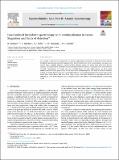| dc.contributor.author | Delaney, B. | |
| dc.contributor.author | Hayden, P. | |
| dc.contributor.author | Kelly, T.J. | |
| dc.contributor.author | Kennedy, E.T | |
| dc.contributor.author | Costello, J.T. | |
| dc.date.accessioned | 2022-09-19T11:27:08Z | |
| dc.date.available | 2022-09-19T11:27:08Z | |
| dc.date.copyright | 2022 | |
| dc.date.issued | 2022-04-29 | |
| dc.identifier.citation | B. Delaney, P. Hayden, T.J. Kelly, E.T. Kennedy, J.T. Costello, Laser induced breakdown spectroscopy with annular plasmas in vacuo: Stagnation and limits of detection, Spectrochimica Acta Part B: Atomic Spectroscopy, Volume 193, 2022, 106430, ISSN 0584-8547, https://doi.org/10.1016/j.sab.2022.106430. | en_US |
| dc.identifier.uri | http://research.thea.ie/handle/20.500.12065/4043 | |
| dc.description.abstract | The purpose of this study is to investigate the possible improvement of the limit of detection of laser induced breakdown spectroscopy using the stagnation layer formed at the centre of an annular plasma. An axicon was used to form an annular plasma on various certified reference targets, the spectra from which were used to construct calibration curves and extract the limit of detection for the system. Comparisons were drawn between the limit of detection for the annular case, dual colliding plasma case and a single plasma case. Clear signal enhancement for certain spectral lines can be seen in the presented spectra. The limits of detection between systems are similar, but the stagnation layer produced from an annular plasma produces the lowest value, for the lowest laser power density and hence least target damage. The signal enhancement and improved limit of detection, at lower power densities, from a stagnation layer at the centre of an annular plasma is a promising result. | en_US |
| dc.format | application/pdf | en_US |
| dc.language.iso | eng | en_US |
| dc.publisher | Elsevier B.V. | en_US |
| dc.relation.ispartof | Spectrochimica Acta Part B: Atomic Spectroscopy | en_US |
| dc.rights | Attribution-NonCommercial-ShareAlike 4.0 International | * |
| dc.rights.uri | http://creativecommons.org/licenses/by-nc-sa/4.0/ | * |
| dc.subject | Annular plasmas | en_US |
| dc.subject | Colliding plasmas | en_US |
| dc.subject | Limit of detection | en_US |
| dc.subject | LIBS | en_US |
| dc.title | Laser induced breakdown spectroscopy with annular plasmas in vacuo: Stagnation and limits of detection | en_US |
| dc.type | info:eu-repo/semantics/article | en_US |
| dc.contributor.affiliation | School of Physics, Science Centre North, University College Dublin, Belfield, Dublin 4, Ireland | en_US |
| dc.contributor.affiliation | School of Physical Sciences, Dublin City University, Glasnevin, Dublin 9, Ireland | en_US |
| dc.contributor.affiliation | Department of Computer Science and Applied Physics, Atlantic Technological University, Galway, Ireland | en_US |
| dc.contributor.sponsor | BD acknowledges the support of the Irish Research Council through the award of a Government of Ireland Postgraduate Scholarship. Work supported by Science Foundation Ireland Grant Nos. 12/IA/1742 and 19 FFP/6956 along with Sustainable Energy Authority of Ireland (SEAI) Grant No. 19/RDD/556. The work is associated with EU H2020 COST Action No. CA17126 (TUMIEE). | en_US |
| dc.description.peerreview | yes | en_US |
| dc.identifier.doi | 10.1016/j.sab.2022.106430 | en_US |
| dc.identifier.url | https://www.sciencedirect.com/science/article/pii/S058485472200074X | en_US |
| dc.rights.accessrights | info:eu-repo/semantics/openAccess | en_US |
| dc.subject.department | Department of Computer Science and Applied Physics, | en_US |
| dc.type.version | info:eu-repo/semantics/publishedVersion | en_US |
| dc.relation.projectid | info:eu-repo/grantAgreement/12/IA/1742 | en_US |


